跨文化交际实训课件Chapter-2
chapter-2跨文化交际

Eyxoteurr natatelnntiooinsaew(a外y f部rom干t扰he)cma:ensbsaegteh.e sights, sounds, and other stimuli that draw
Inwteitrhnthael mnoesissaeg(e.内部干扰):refers to your thoughts and feelings that can interfere
Semantic noise(语义干扰): refers to how alternative meanings of the source’s
message symbols can be distracting.
Decoding(解码): Decoding is the opposite process of encoding and just as much an
第10页,共25页。
Chapter 3 Communication
2. Components of communication
Source (信息源)
The source is the person with an idea he or she desires to communicate.
Encoding (编码)
defined as the environment in which the communication takes place and which helps define the communication.
第12页,共25页。
Chapter 3 Communication
Feedback
Response
Message (信息)
The term message identifies the encoded thought. Encoding is the process, the verb; the message is the resulting object.
unit 2 跨文化交际课件

1
1
Chapter 2: Becoming aware
• 3. Characteristics of culture
• Culture is the total accumulation of beliefs, customs, values, behaviors, institutions and communication patterns that are shared, learned and passed down through the generations in an identifiable group of people.
1
1
Chapter 2
Becoming aware
1
1
Chapter 2: Becoming aware
• 1. What is culture? • The first step in learning to communicate across cultures, is to consider what people mean when they talk about culture. • The most usual meaning is that culture refers to people’s customs and behavior.
1
1
Chapter 2: Becoming aware
Level 1: Cultural differences are exotic Level 2: Cultural differences are frustrating Level 3: The different culture is believable Level 4: The different culture is believable as lived experience.
跨文化交际第二PPT课件
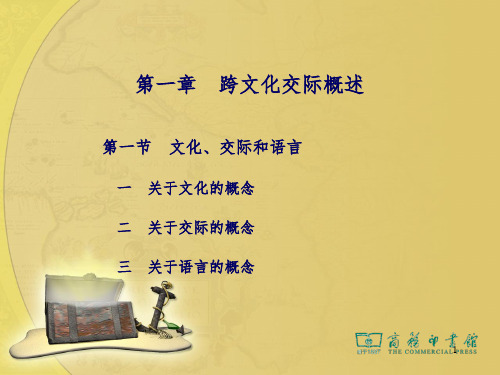
13
文化定势的特征
首先,定势和归类有一定的联 系,是过分简单化的归类。 其次,定势有不可避免性 再者,定势具有稳定性和延续 性。
14
第一章 跨文化交际概述
第一节 文化、交际和语言
4、亚文化
在文化学研究领域,通常把文化分为主流文化和亚文化。 也就是说,文化的概念具有层次性,一种整体文化中往往包含 了各种不同的次范畴“变体”,形成某种文化圈内的亚文化圈。
3
第一章 跨文化交际概述
第一节 文化、交际和语言
后来“文化”一词被日语借入,到近代作为英 语culture的对译词。再后来“文化”作为日语借词 又被现代汉语吸收,于是“文化”就同英语的 culture有了直接的词源关系,并衍生出“文明”、 “教育”等含义。
4
什么是文化?
文化离不开 人,是某一 群体的生活 方式。
第一章 跨文化交际概述
第一节 文化、交际和语言
一 关于文化的概念 二 关于交际的概念 三 关于语言的概念
1
第一章 跨文化交际概述
第一节 文化、交际和语言
一 关于文化的概念
(一)文化的定义
1.中西文化探源
“文化”的概念古已有之,指与“武力”相对的文德教化。
圣人之治天下也,先文德而后武力。凡武之兴,为不服也;文化不
第一节 文化、交际和语言
在文化学或文化人类学中,“文化”一词通常指人
类社会区别于其他动物的全部活动方式以及活动的产品。
就这一概念的核心内涵而言,它的意义是明确的。然而
专家们给“文化”所下的定义可以说各有千秋。在众多
的关于文化的定义中,文化人类学家泰勒(Tylor)和马
林诺夫斯基(Malinowski)的定义比较受人推崇。前者
跨文化交际导论课件2
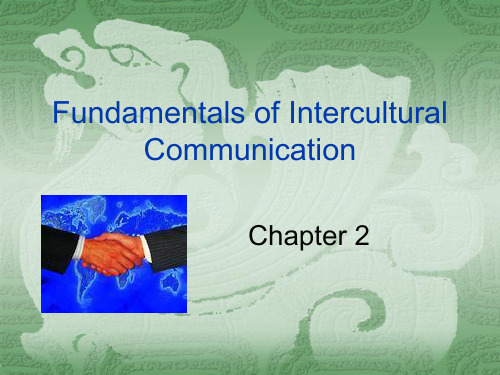
Further Explanation
There are at least two or more people: In terms of who communicate with whom, whether it being human, animals or machines, the classification is as follows: Human communication Animal communication Human-animal communication Human-machine communication Machine-to-machine communication
Further Explanation
There is a language shared between communicators.
Human language
Verbal
Nonverbal
Non-word sounds
Body language
e.g. Chinese, English
e.g. Sounds uttered to control
III. The Classification of Communication
Communication occurs when – there are at least two or more people. there is some contact between communication. there is a language shared by communicators. there is an exchange of information that has taken place.
跨文化交际第二章文化与跨文化交际

The Basic Function of Culture
❖ At the core of culture is the idea that it is intended to make life easier for people by “teaching” them how to adapt to their surroundings.
Generation. ❖ Culture Is Based on Symbols. ❖ Culture Is Subject to Change. ❖ Culture Is an Integrated System. ❖ Culture Is Ethnocentric.
Culture Is Not Innate; It Is Learned.
❖ The English admire good manners, courtly behavior, and dignity, as is reflected in the “Canterbury Tales”.
❖ The Japanese learn about the importance of duty, obligation, and loyalty from “The Tale of the Forty-Seven Ronin”.
Proverbs
❖ "One does not make the wind blow but is blown by it."
❖ "Order is half of life."
❖ "The mouth maintains silence in order to hear the heart talk."
跨文化交际2

While in Japanese, you can only understand the affirmative or negative meaning after the speaker has finished the sentences.
Tense The dog bit the man in English Dog bite man in Chinese
Synonyms 同义词 Idioms习惯用语 Proverbs谚语 Styles / Varieties Slang, Taboo Expressions俚语 禁忌语 Euphemisms委婉语
2.1.2 MORPHOLOGY
A morpheme if the small unit of a language that has a meaning.
-s in dogs, means plural un- means negative in undo er-means who does it in teacher
Even the natives speak different sublanguages with utterly different sounds.
b (便), 2. p (边), 3. p' (片), 4. m (面), 5. f (火), 6. v (武), 7. d (电), 8. t (店), 9. t' (天), 10. n (呢), 11. l (连), 12. g (个), 13. k (该), 14. k' (开), 15. h (海), 16. ɦ (孩), 17. ŋ (呆), 18. tɕ (尖), 19. tɕ' (千), 20. ɕ (先), 21. dʑ (健), 22. ȵ (念), 23. j (夜), 24. ts (鸡), 25. ts' (溪), 26. s (输), 27. dz (住), 28. z (事), 29. 0 (无声母) 韵母 1. ɿ (志), 2. i (天), 3. u (火), 4. y (女), 5. a (板), 6. ia (晓), 7. ua (弯), 8. ɛ (杏), 9. iɛ (叫), 10. uiɛ (奣), 11. e (改), 12. ə (毛), 13. ø (看), 14. uɔ (炒), 15. yɔ (重), 16. o (巴), 17. yo (玉), 18. ai (北), 19. iai (吸), 20. uai (㾯), 21. ei (非), 22. au (斗), 23. iau (久), 24. ɣu (左), 25. ieu (手), 26. øy (夫), 27. aŋ (本), 28. ianŋ (斤), 29. uaŋ (温), 30. eŋ (井), 31. oŋ (送), 32. yoŋ (中), 33. m (?(轻 音)), 34. n (唔(轻音)), 35. ŋ (儿(轻音))
教学课件 跨文化交际实训(第二版)房玉靖

background • we use “跨文化交际” for intercultural communication. But some
people also use “跨文化沟通” or “跨文化交流”.
shaped, and transmitted by culture
Key Terms
• Communication交际
交际一词的英语是 communication,这个词源于拉丁文 communis,意思是“共享”、“共有”。交际, 即人 类发出和接收信息的行为和过程。包括语言交流、非 语言交流、书面交流和视觉交流
I. Culture 文化
• Metaphors in Байду номын сангаасulture 文化中的隐喻
▪The Culture Iceberg 文化冰山
▪The Culture Onion 文化洋葱
I. Culture 文化
• Characteristics of Culture 文化的特点
▪ Culture is shared ▪ Culture is learned ▪ Culture is based on symbols ▪ Culture is dynamic
II. Communication 交际
• Definitions of Communication 交际的定义 • Can you find a Chinese equivalent to the English word communication? Circle the item that you consider suitable. • 沟通 传播 通信 交流 交际 传通
跨文化交际Chapter 2
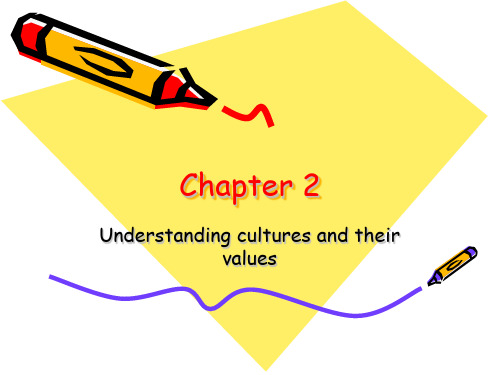
Culture is adaptive
Culture is adaptive
Culture is adaptive
Metaphors of culture --- culture is like an iceberg
Metaphors of culture --- culture is like an iceberg
Definitions of Culture
Historically, “culture” derives from Latin word “colere”. Culture usually refers to sth that derives from or created by the intervention of humans ----- culture is cultivated. No less than 164 definitions of culture (Kroeber and Kluckhohn, 1952);
• Culture is ongoing and subject to change; • Culture seldom remain constant; • They can produce change through the mechanisms of invention and diffusion. • Culture changed also because of (1) laws, (2) shifts in values, (3) natural disasters, (4) wars, or other calamities. The most significant is (5) economic change. • “Change” involves adaptation.
跨文化交际unit 2 课件
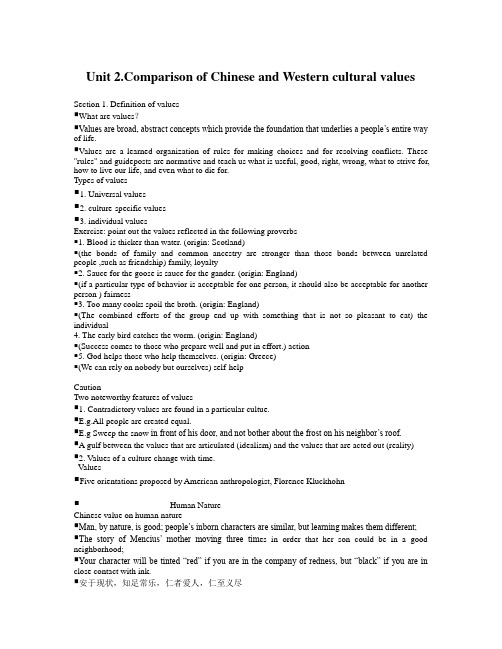
Unit parison of Chinese and Western cultural values Section 1. Definition of values▪What are values?▪V alues are broad, abstract concepts which provide the foundation that underlies a people‘s entire way of life.▪V alues are a learned organization of rules for making choices and for resolving conflicts. These "rules" and guideposts are normative and teach us what is useful, good, right, wrong, what to strive for, how to live our life, and even what to die for.Types of values▪1. Universal values▪2. culture-specific values▪3. individual valuesExercise: point out the values reflected in the following proverbs▪1. Blood is thicker than water. (origin: Scotland)▪(the bonds of family and common ancestry are stronger than those bonds between unrelated people ,such as friendship) family, loyalty▪2. Sauce for the goose is sauce for the gander. (origin: England)▪(if a particular type of behavior is acceptable for one person, it should also be acceptable for another person ) fairness▪3. Too many cooks spoil the broth. (origin: England)▪(The combined efforts of the group end up with something that is not so pleasant to eat) the individual4. The early bird catches the worm. (origin: England)▪(Success comes to those who prepare well and put in effort.) action▪5. God helps those who help themselves. (origin: Greece)▪(We can rely on nobody but ourselves) self-helpCautionTwo noteworthy features of values▪1. Contradictory values are found in a particular cultue.▪E.g.All people are created equal.▪E.g Sweep the snow in front of his door, and not bother about the frost on his neighbor‘s roof.▪A gulf between the values that are articulated (idealism) and the values that are acted out (reality)▪2. V alues of a culture change with time.V alues▪Five orientations proposed by American anthropologist, Florence Kluckhohn▪Human NatureChinese value on human nature▪Man, by nature, is good; people‘s inborn characters are similar, but learning makes them different;▪The story of Mencius‘ mother moving three tim es in order that her son could be in a good neighborhood;▪Y our character will be tinted ―red‖ if you are in the company of redness, but ―black‖ if you are in close contact with ink.▪安于现状,知足常乐,仁者爱人,仁至义尽▪Relationship of human to natureChinese traditional medicine shows the cultural value of harmony with nature▪Westerners: A minor illness like cold - work as usual; human body is an object that can be studied and then controlled---leading to the invention of powerful medicines, but the medicines may have unpleasant or even dangerous died effects.▪Chinese: cold- stayed home to give body a chance to recover. The human body is part of nature and needs to be brought back into balance. Medi cine should work with the body‘s own resources. It should be integrated with the body, so it will take longer to work.▪Sense of timeActivity---case study▪When a middle age American couple showed up to help a young Chinese couple move into their new apartment, they were surprised that the Chinese couple would not allow them to do any work. Instead they found a place for them to sit and gave them tea.▪Why?▪Activityconflict▪Westerners: experience the talk and behavior of Chinese people as performance, as dramatization of the self and as not very relevant to what is important; their conversation is lacking in information.▪Chinese: showing that they are friendly, virtuous, or sufficiently important; they are educated, polite, humble, high-ranking or hospitable.▪―我爸是李刚。
跨文化交际第二章文化与跨文化交际ppt课件
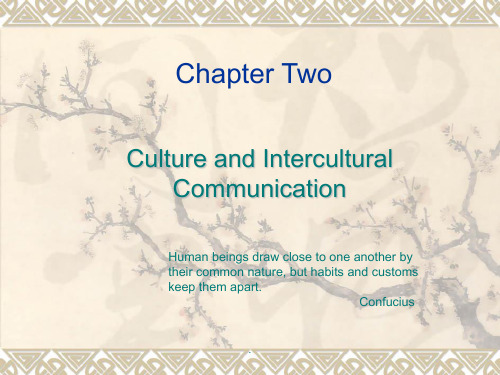
Culture
❖ Some people in many parts of the world put dogs in their ovens, but people in the United States put them on their couches and beds. Why?
❖ Some people in Iran pray five times each day while sitting on the floor, but some people in Las Vegas sit up all night in front of video poker machines. Why?
Confucius
.
Warm-up Case
❖ Fish Is Fish
.
Learning Objectives
❖ Define the term of culture ❖ Describe the characteristics of culture ❖ Understand the nature of culture ❖ Be aware of cultural differences
Learning Culture through
Proverbs
❖ "One does not make the wind blow but is blown by it."
❖ "Order is half of life."
❖ "The mouth maintains silence in order to hear the heart talk."
The formal teaching of a culture is far more structured and is often left to the various institutions of the culture, such as schools and churches.
跨文化交际实用教程unit2课件ppt共30页
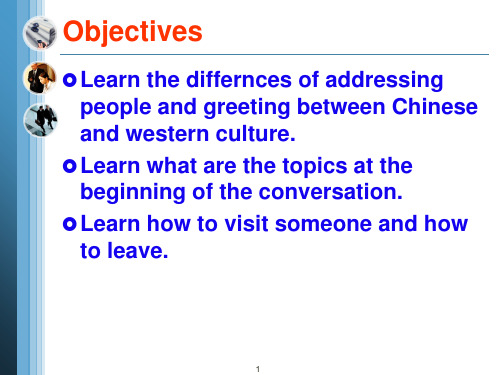
1
CONTENTS
I. Warm-up cases II. Detailed Study:
★Addressing People ★Greetings ★Initiating Conversations ★Visiting Someone ★Partings
■学术头衔
学术头衔的“副”职称,常用 associate 表示。如:
➢ 副教授 associate professor ➢ 副研究员 associate research fellow ➢ 副审判长 associate judge ➢ 副主任医师 associate doctor
10
2. Greetings
Please match the following two groups.
vice
director
associate
professor
assistant
manager
deputy
president
9
Tips:
■行政头衔
以“副”字的表示副职的行政职务头衔,可用 vice、 deputy 表达。在实际使用时究竟选用哪个,纯属搭配 习惯。一般来说,vice与president、 premier、 chairman、 minister、 governor搭配;deputy与 director、 chief、head 、secretary、dean、mayor 搭配。似乎可以认为,Vice比Deputy的搭配级别要高。
Close Relationship/ Informal Situation
Surname+Title Surname+Title
chapter 2跨文化交际贾玉新

The process of learning to be an anthropocosmic person
What do we need under today’s multi linguistic society? P28
intercultural communications
intercultural communications
❓
a commonly shared future
a commonly shared future
a global communicative and dialogic ethic
genuine intercultural dialogue
anybody • dynamic:rather than static
“Learning to be human” process
self-as-center relationship
• the human self embraces social and moral responsibilities and obligations for other, the world,and the cosmos.
• independence • autonomy • dichotomy
仁: a continuous, holistic and dynamic way of learning to be human P24-25
• continuous: always on the way of learning to be human • holistic: embracing the whole of humanity, do not exclude
跨文化商务沟通chapter 2PPT课件

Байду номын сангаас
Geert Hofstede
▪ The collective programming of the mind which distinguishes the members of one category of people from another.
▪ Culture is “software of the mind”.
5
From Intellectual Perspective
▪ Culture is “the arts and other manifestations of human intellectual achievement regarded collectively”.
6
From Anthropologic Perspective
12
Edward T. Hall
▪ Culture is the total accumulation of beliefs, customs, values, behaviors, institutions and communication patterns that are shared, learned and passed down through the generations in an identifiable group of people.
▪ Culture is “the customs, civilizations, and achievements of a particular time or people”.
7
Edward Tylor
▪ Culture…is that complex whole which includes knowledge, belief, art, law, morals, custom, and any other capabilities and habits acquired by man as a member of society.
Cross-CulturalCommunicationUnit1-4跨文化交际.ppt

CHAPTER 1 - Communication and Culture: The Challenge of The Future
Dominant Culture
Co-Cultures
• It's the one in power -
• They are numerous.
control.
• Distinct and unique
• We learned our culture through mass media
• Culture is transmitted from generation to generation
• Culture is based on symbols
• Culture is subjected to change
• Subjective elements include: values, beliefs, attitudes, orientations, and underlying assumptions prevalent among people in the society.
• Basic functions of Culture: adapt to a particular ecology, and includes the knowledge that people need to have in order to function in their own social environment.
• Culture is integrated
• Culture is adaptive
CHAPTER 1 - Communication and Culture: The Challenge of The Future
跨文化交际Unit-2第二讲PPT课件

2021/3/12
6
Chapter 1 Culture and Intercultural Communication
(2) How do you think of “self-reliance”?
• The American Creed is something of a doubleedged sword: it fosters a high sense of personal responsibility, independent initiative, and voluntarism ; it also encourages self-serving behavior, atomism, and a disregard for communal good. More specifically, its emphasis on individualism threatens traditional forms of community morality, and thus has historically promoted a particularly virulent strain of greedy behavior”
• Play a role • To feel an obligation toward
2021/3/12
跨文化交际实训课件Chapter-2

Language and culture 语言和文化
I. Verbal Communication 言语交际
High-context and Low-context language
高语境和低语境语言
High Context Less verbally explicit communication, less written/formal information More internalized understandings of what is communicated Multiple cross-cutting ties and intersections with others Long term relationships Strong boundaries- who is accepted as belonging vs. who is considered an "outsider" Knowledge is situational, relational. Decisions and activities focus around personal face-to-face relationships, often around a central person who has authority. Examples: Small religious congregations, a party with friends, family gatherings, expensive gourmet restaurants and neighborhood restaurants with a regular clientele, undergraduate on-campus friendships, regular pick-up games, hosting a friend in your home overnight.
- 1、下载文档前请自行甄别文档内容的完整性,平台不提供额外的编辑、内容补充、找答案等附加服务。
- 2、"仅部分预览"的文档,不可在线预览部分如存在完整性等问题,可反馈申请退款(可完整预览的文档不适用该条件!)。
- 3、如文档侵犯您的权益,请联系客服反馈,我们会尽快为您处理(人工客服工作时间:9:00-18:30)。
Warm-up How do people carry out their communication?
What is verbal communication? What do plum blossom, orchid, bamboo, and
chrysanthemum stand for in Chinese? Do they have the same meanings in English? How many terms do you know when you express thanks in Chinese? What topics do you think is appropriate when you first meet a foreigner from America?
跨文化交际实训
ISBN:978-7-81134-892-7 2010年11月 第1版
Chapter 2 Verbal Commves In this chapter, you should be able to Understand some commonly observed differences between English and Chinese verbal communication. Learn to make cross-cultural comparisons and analysis in the following aspects: • Cultural differences on lexical semantics level • Cultural differences on pragmatic level Learn to carry out oral communication. Learn to carry out written communication.
I. Verbal Communication 言语交际
Language and culture 语言和文化
I. Verbal Communication 言语交际
High-context and Low-context language
高语境和低语境语言
High Context Less verbally explicit communication, less written/formal information More internalized understandings of what is communicated Multiple cross-cutting ties and intersections with others Long term relationships Strong boundaries- who is accepted as belonging vs. who is considered an "outsider" Knowledge is situational, relational. Decisions and activities focus around personal face-to-face relationships, often around a central person who has authority. Examples: Small religious congregations, a party with friends, family gatherings, expensive gourmet restaurants and neighborhood restaurants with a regular clientele, undergraduate on-campus friendships, regular pick-up games, hosting a friend in your home overnight.
I. Verbal Communication 言语交际
Low Context Rule oriented, people play by external rules More knowledge is codified, public, external, and accessib Sequencing, separation--of time, of space, of activities, of relationships More interpersonal connections of shorter duration Knowledge is more often transferable Task-centered. Decisions and activities focus around what needs to be done, division of responsibilities. Examples: large US airports, a chain supermarket, a cafeteria, a convenience store, sports where rules are clearly laid out, a motel.
I. Verbal Communication 言语交际
The Relationship Between Language and Culture 语言与文化的关系
▪ Language and culture are like a living organism. Language is flesh, while culture is blood. Without culture, language would be dead; without language, culture would have no shape.
